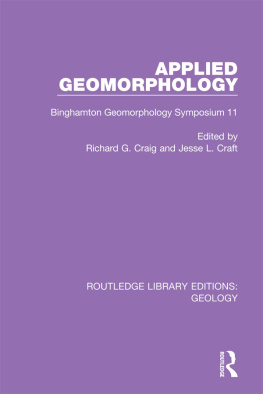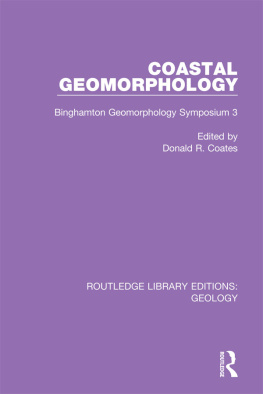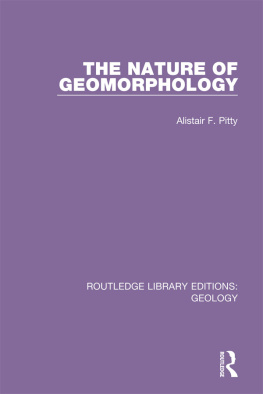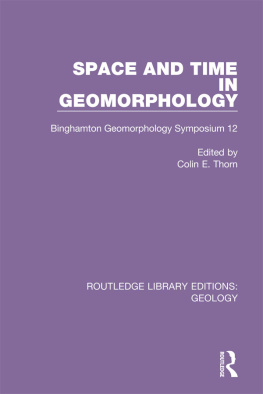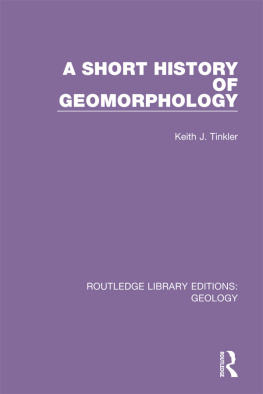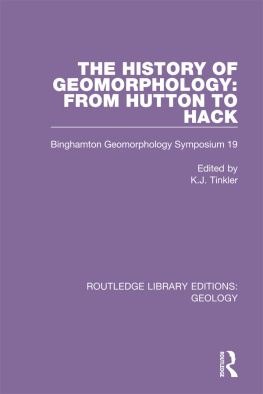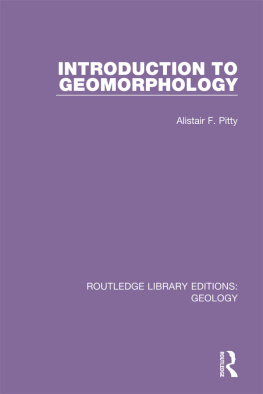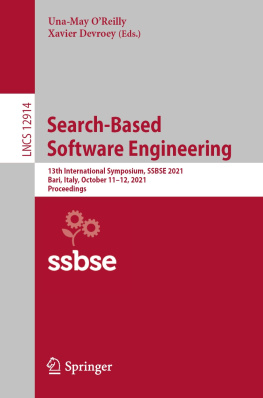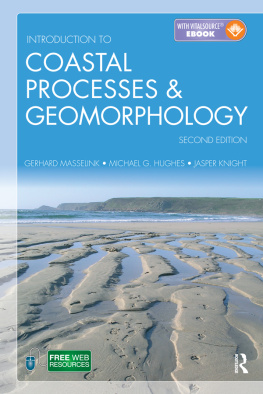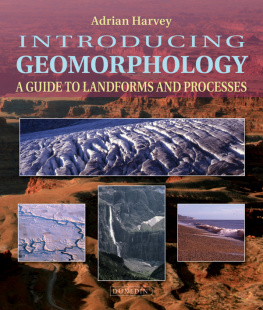Contents
Guide
Print Page Numbers

ROUTLEDGE LIBRARY EDITIONS:
GEOLOGY
Volume 3
APPLIED GEOMORPHOLOGY
APPLIED GEOMORPHOLOGY
Binghamton Geomorphology Symposium 11
Edited by
RICHARD G. CRAIG AND JESSE L. CRAFT

First published in 1982 by George Allen & Unwin Ltd
This edition first published in 2020
by Routledge
2 Park Square, Milton Park, Abingdon, Oxon OX14 4RN
and by Routledge
52 Vanderbilt Avenue, New York, NY 10017
Routledge is an imprint of the Taylor & Francis Group, an informa business
1982 R.G. Craig, J.L. Craft and the contributors
All rights reserved. No part of this book may be reprinted or reproduced or utilised in any form or by any electronic, mechanical, or other means, now known or hereafter invented, including photocopying and recording, or in any information storage or retrieval system, without permission in writing from the publishers.
Trademark notice: Product or corporate names may be trademarks or registered trademarks, and are used only for identification and explanation without intent to infringe.
British Library Cataloguing in Publication Data
A catalogue record for this book is available from the British Library
ISBN: 978-0-367-18559-6 (Set)
ISBN: 978-0-429-19681-2 (Set) (ebk)
ISBN: 978-0-367-46178-2 (Volume 3) (hbk)
ISBN: 978-1-00-302746-1 (Volume 3) (ebk)
Publishers Note
The publisher has gone to great lengths to ensure the quality of this reprint but points out that some imperfections in the original copies may be apparent.
Disclaimer
The publisher has made every effort to trace copyright holders and would welcome correspondence from those they have been unable to trace.
APPLIED
GEOMORPHOLOGY
EDITED BY: RICHARD G. CRAIG
Kent State University
JESSE L. CRAFT
U.S. Bureau of Mines
A proceedings volume of the eleventh annual Binghamton geomorphology symposium held at Kent State University, Ohio, October 25, 1980
GEORGE ALLEN & UNWIN
London Boston Sydney
First published in 1982
This book is copyright under the Berne Convention. All rights are reserved. Apart from any fair dealing for the purpose of private study, research, criticism or review, as permitted under the Copyright Act, 1956, no part of this publication may be reproduced, stored in a retrieval system, or transmitted, in any form or by any means, electronic, electrical, chemical, mechanical, optical, photocopying, recording or otherwise, without the prior permission of the copyright owner. Enquiries should be sent to the publishers at the undermentioned address:
GEORGE ALLEN & UNWIN LTD
40 Museum Street, London WC1A 1LU
R. G. Craig, J. L. Craft, and the contributors
British Library Cataloguing in Publication Data
Applied geomorphology. (The Binghamton symposia series in geomorphology. International series; no. 11)
1. GeomorphologyCongresses
I. Craig, Richard G. II. Craft, Jesse L.
III. Series
551.4 GB400.2
ISBN 0-04-551050-4
Library of Congress Cataloging in Publication Data
Binghamton Geomorphology Symposium (11th: 1980: Kent State University)
Applied geomorphology.
(The Binghamton symposia; 11)
Includes index.
1. GeomorphologyCongresses. I. Craig, Richard G.
II. Craft, Jesse L. III. Title. IV. Series.
GB400.2.B56 1980 551.4 81-22791
ISBN 0-04-551050-4 AACR2
Printed and bound in Great Britain by
Mackays of Chatham Ltd
CONTENTS
Geomorphologists tend to consider all geomorphologic research to be applied. In the sense that each advance in knowledge provides a clearer view of how the earth works, we must all be applied scientists. Yet too much of our work remains obscure and poorly understood by those who are most likely to benefit from it. Very important research remains unavailable theory only because it is difficult to interpret and many of us are too busy extending our own research to help others make use of it. Thus the purpose of this book is not to codify a distinct set of methods and data that represent a branch of knowledge called applied geomorphology. Rather it is designed to show geomorphology as it is (and can be) applied to current problems facing the people of the world.
We have tried to make this sampling a representative one. But that means weighting the possible contributions; and weights can be made in several ways. We chose to emphasize problems that are encountered where man lives on the one hand and where man interacts with the surface through important construction projects on the other.
A large part of the worlds population lives near the ocean. So processes shaping that environment must be of prime consideration for many of us. Accordingly, four chapters are devoted to various coastline phenomena. It is important to recognize that shore erosion is not the only problem facing us. Coastal subsidence can also have devastating effects. Thus our sampler covers erosion along oceans where emergence is occurring (Chapter 11), where submergence is occurring (Chapter 9), along large inland bodies of water where the processes have a special mix (Chapter 10), and finally we look at the case of subsidence accompanied by deposition (Chapter 12).
Another morphogenetic region with which man is constantly interacting is that area glaciated only recently. Here a number of problems exist, including: where to live, how to construct facilities where climate is extreme and glacial and periglacial processes still active, and how to dispose of our wastes. Fiksdal outlines methods to deal with the first (Chapter 3), Clague (Chapter 2) presents an excellent example of the second, and Hatheway and Bliss (Chapter 4) deal with the last.
Two other environments of immediate concern to man are more restricted but present uniquely exasperating problems. Carbonate terrains, which may have been avoided in the past, are now increasingly subject to development. Sheedy and coauthors (Chapter 13) describe some situations that the applied geomorphologist encounters in such terrain. A second area of growing importance is presented by the problems unique to certain areas in the midwest and south-central parts of the United States. The particular problem of expanding soils has grown acute because of the building boom occurring in states such as Texas. The lesson to be learned here is that the job of the geomorphologist requires that (s)he be both specialized and adaptable. As societies needs are redefined, so must be geomorphologists abilities.
We include a set of examples of specific applications of geomorphic knowledge and techniques. A number of these result from the increasing scale of construction projects: for example, the geotechnical problems associated with the MX missile problem (Chapter 7) and the giant natural gas pipeline project (Chapter 2). A third example arises when we contemplate the disposal of radioactive waste in salt domes. A necessary condition is that these domes must be demonstrably stable on the time scale of tens of thousands of years. This question is considered in Chapter 5.
Computer applications in geomorphic studies are becoming increasingly important. Vanderpool (Chapter 14) shows how the computer can be used to study the stability of landforms. Craig (Chapter 8) considers some geomorphic constraints that must apply in such models.

